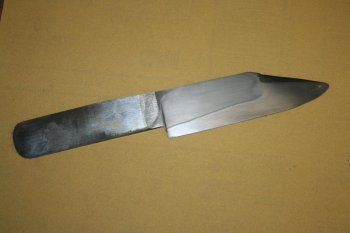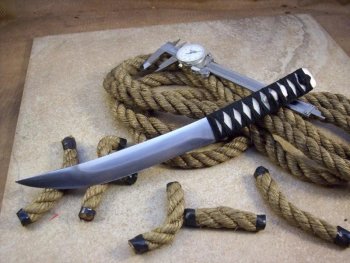Doug Lester
Well-Known Member
One of the steels that I work with is 9260 and not too long ago it was pointed out to me that it was a steel that would display a quench line or hamon with clay quenching. So I decided to make a test blade with it and give the technique a try. The blade below was forged, given a rough grind and coated with furnice patch that I had thinned out just slightly with water before applying maybe 3/16" thick. It was austinized to a little above non-magnetic and quenched in peanut oil heated to about 130 degrees and tempered at 400 degrees. I actually had to harden twice because I didn't achieve good hardness the first time around. I figured that I didn't quite achieve austinization the first time around so I repeated the process getting the steel just a little hotter. No soak other than to make sure the steel was heated through.
I ground it out to 600 grit on the grinder then switched to hand sanding with WD-40 as a lubricant. I took it all the way out to 1500 grit, hoping that I might see something with just polishing. Nothing showed with polishing but it popped right up with ferric chloride mixed 1:4 parts in distilled water.
Below is the knife which will be given a simple handle and tested with chopping and slicing before I break the blade to check toughness and grain size. I did experiment with a hollow grind on the clip, but that didn't turn out well.

Doug
I ground it out to 600 grit on the grinder then switched to hand sanding with WD-40 as a lubricant. I took it all the way out to 1500 grit, hoping that I might see something with just polishing. Nothing showed with polishing but it popped right up with ferric chloride mixed 1:4 parts in distilled water.
Below is the knife which will be given a simple handle and tested with chopping and slicing before I break the blade to check toughness and grain size. I did experiment with a hollow grind on the clip, but that didn't turn out well.

Doug

